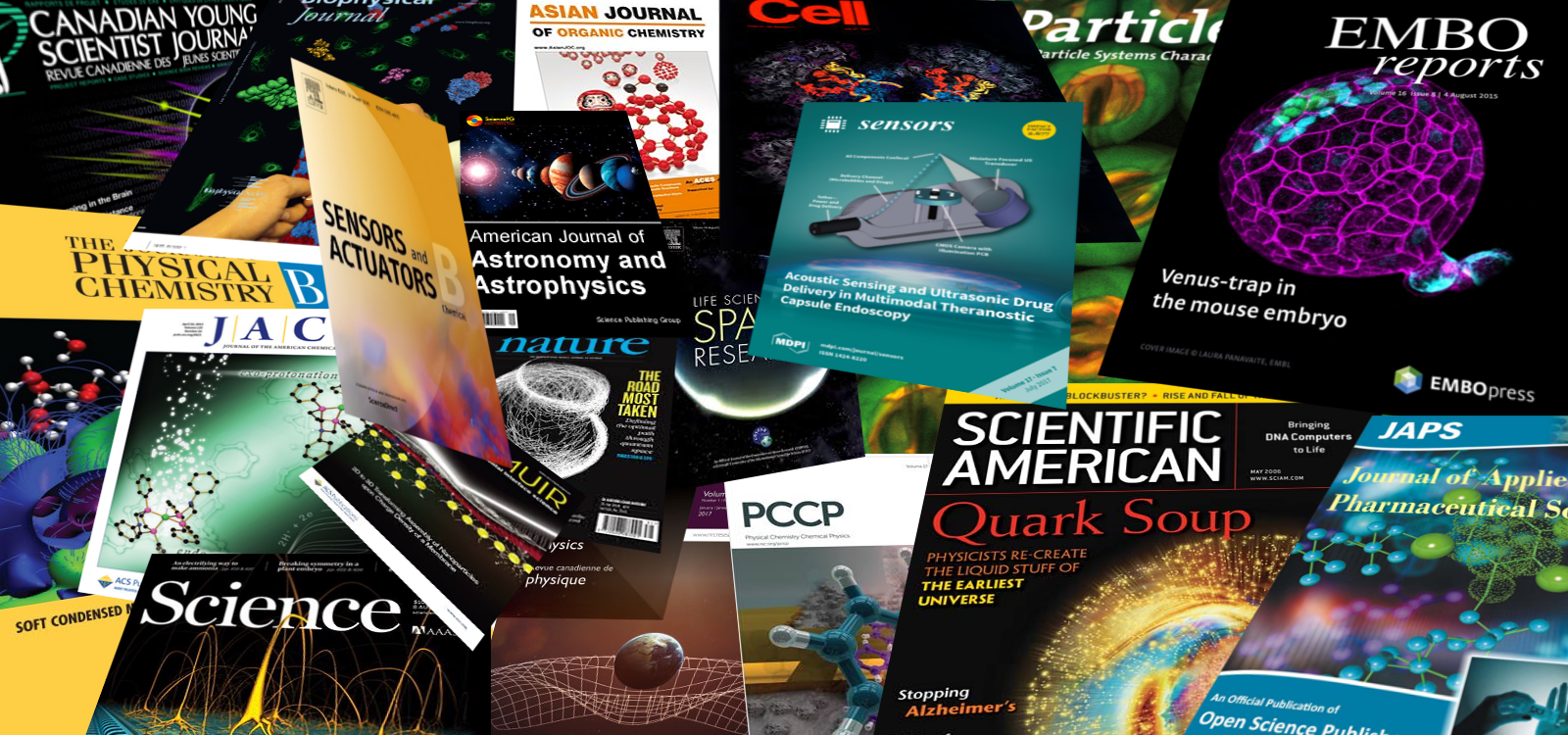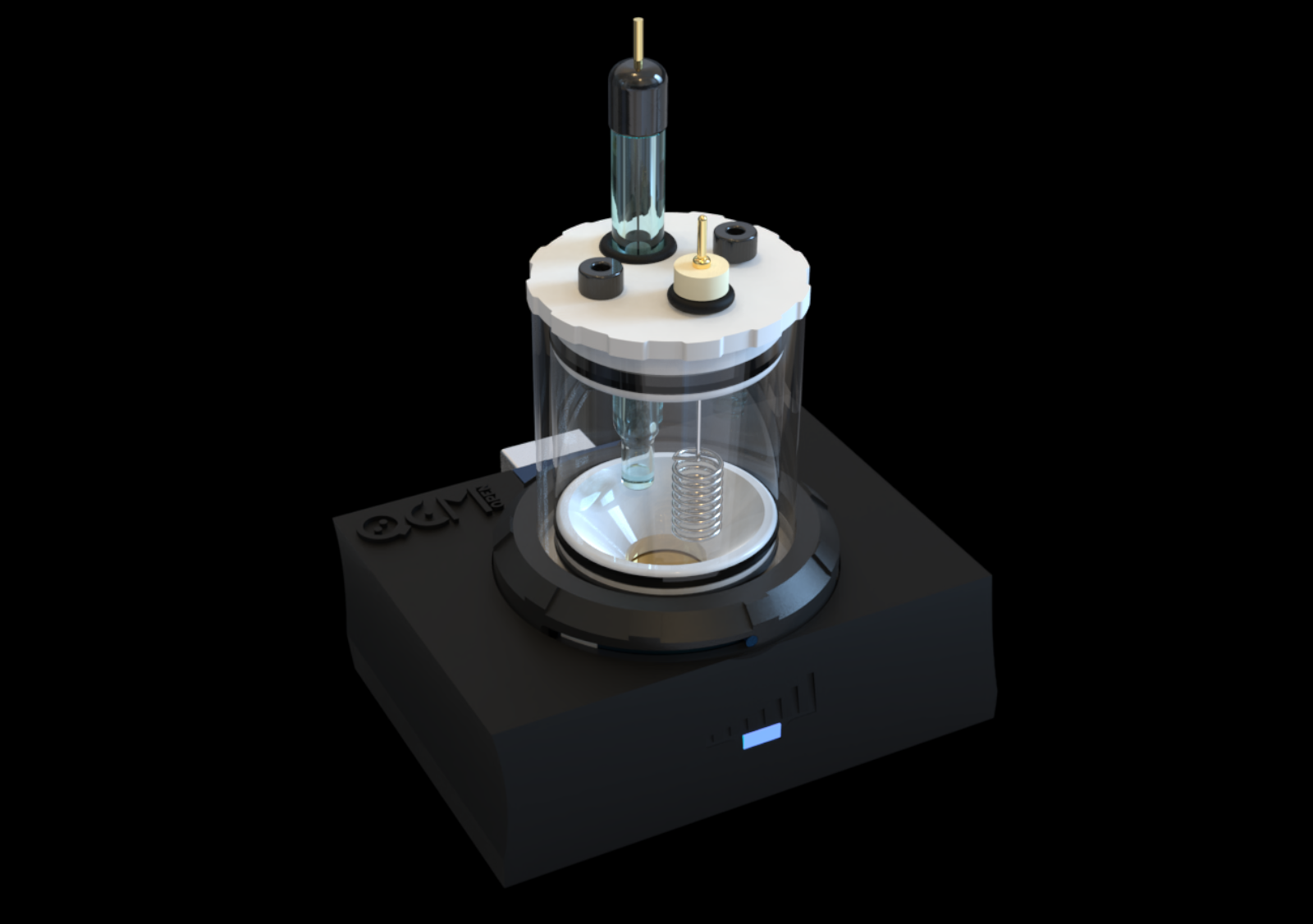openQCM – Powered by Novaetech S.r.l

Scientific Papers
Publications citing the applications of openQCM (by Novaetech S.r.l.) instruments and accessories in scientific research.
The list of scientific papers published on the most important journals showing the usage of openQCM in several scientific fields, such as thin film deposition, chemical sensors, biological research and biosensors.
Because of the large number of publications, we are reorganizing everything by subject areas. This will take some time. Thank you for your patience
2025
Tozzetti, Martina; Martina, Maria Raffaella; Lucchesi, Giacomo; Vasa, Kristian; Ishaq, Ahtsham; Marsili, Laura; Procacci, Piero; Menichetti, Stefano; Caminati, Gabriella
Ultrasensitive Detection of FKBP12 Using a Synthetic Receptor-Functionalized QCM Nanoplatform Journal Article
In: Advanced Sensor Research, vol. n/a, no. n/a, pp. e00053, 2025.
Abstract | Links | BibTeX | Tags: biomarker sensing, FKBP12 detection, nanosensors, openQCM Wi2, point-of-care diagnostics, Quartz Crystal Microbalance (QCM), Self-Assembled Monolayers (SAMs), synthetic receptors
@article{https://doi.org/10.1002/adsr.202500053,
title = {Ultrasensitive Detection of FKBP12 Using a Synthetic Receptor-Functionalized QCM Nanoplatform},
author = {Martina Tozzetti and Maria Raffaella Martina and Giacomo Lucchesi and Kristian Vasa and Ahtsham Ishaq and Laura Marsili and Piero Procacci and Stefano Menichetti and Gabriella Caminati},
url = {https://advanced.onlinelibrary.wiley.com/doi/abs/10.1002/adsr.202500053},
doi = {https://doi.org/10.1002/adsr.202500053},
year = {2025},
date = {2025-08-07},
journal = {Advanced Sensor Research},
volume = {n/a},
number = {n/a},
pages = {e00053},
abstract = {Abstract FKBP12, a peptidyl-prolyl isomerase implicated in cancer, neurodegenerative diseases, and post-transplant anti-rejection mechanisms, represents a critical biomarker for early diagnosis and monitoring. Here, a novel diagnostic nanoplatform is presented for the detection of FKBP12 at nanomolar to picomolar concentrations in biological fluids. The platform integrates a gold-coated Quartz Crystal Microbalance (QCM) functionalized with a synthetic receptor (GPS-SH1) and spacers within a Self-Assembled Monolayer (SAM), enabling direct and label-free detection of FKBP12 in complex biological samples. A careful strategy for the in-silico design and custom synthesis of the receptor is adopted, ensuring optimal binding affinity and additional chemical functionalities for surface chemisorption. The designed nano-architecture demonstrates exceptional sensitivity, with a detection limit in the picomolar range, and high selectivity, as confirmed by minimal interference from abundant serum proteins such as Serum Albumin and Immune Gamma Globulin. Furthermore, the SAM-functionalized sensors exhibit remarkable stability, retaining functionality for up to six months under storage conditions. This work not only advances the field of nanoscale biosensing but also provides a robust, reusable tool for FKBP12 detection, with potential applications in point-of-care diagnostics and personalized medicine. The platform's ability to operate in biologically relevant environments underscores its promise for real-world healthcare applications, including early disease diagnostics.},
keywords = {biomarker sensing, FKBP12 detection, nanosensors, openQCM Wi2, point-of-care diagnostics, Quartz Crystal Microbalance (QCM), Self-Assembled Monolayers (SAMs), synthetic receptors},
pubstate = {published},
tppubtype = {article}
}
Abstract FKBP12, a peptidyl-prolyl isomerase implicated in cancer, neurodegenerative diseases, and post-transplant anti-rejection mechanisms, represents a critical biomarker for early diagnosis and monitoring. Here, a novel diagnostic nanoplatform is presented for the detection of FKBP12 at nanomolar to picomolar concentrations in biological fluids. The platform integrates a gold-coated Quartz Crystal Microbalance (QCM) functionalized with a synthetic receptor (GPS-SH1) and spacers within a Self-Assembled Monolayer (SAM), enabling direct and label-free detection of FKBP12 in complex biological samples. A careful strategy for the in-silico design and custom synthesis of the receptor is adopted, ensuring optimal binding affinity and additional chemical functionalities for surface chemisorption. The designed nano-architecture demonstrates exceptional sensitivity, with a detection limit in the picomolar range, and high selectivity, as confirmed by minimal interference from abundant serum proteins such as Serum Albumin and Immune Gamma Globulin. Furthermore, the SAM-functionalized sensors exhibit remarkable stability, retaining functionality for up to six months under storage conditions. This work not only advances the field of nanoscale biosensing but also provides a robust, reusable tool for FKBP12 detection, with potential applications in point-of-care diagnostics and personalized medicine. The platform's ability to operate in biologically relevant environments underscores its promise for real-world healthcare applications, including early disease diagnostics.
2024
Wang, Xintai; Alajmi, Asma; Wei, Zhangchenyu; Alzanbaqi, Mohammed; Wei, Naixu; Lambert, Colin; Ismael, Ali
Enhancing the Pressure-Sensitive Electrical Conductance of Self-Assembled Monolayers Journal Article
In: ACS Applied Materials & Interfaces, 2024.
Abstract | Links | BibTeX | Tags: AFM, Atomic Force Microscopy, Gauge factor, openQCM, Penetration, QCM, Quartz Crystal Microbalance, Self-Assembled Monolayers (SAMs), Tunnelling decay
@article{wang2024enhancing,
title = {Enhancing the Pressure-Sensitive Electrical Conductance of Self-Assembled Monolayers},
author = {Xintai Wang and Asma Alajmi and Zhangchenyu Wei and Mohammed Alzanbaqi and Naixu Wei and Colin Lambert and Ali Ismael},
url = {https://pubs.acs.org/doi/full/10.1021/acsami.4c15796},
doi = {https://doi.org/10.1021/acsami.4c15796},
year = {2024},
date = {2024-11-19},
urldate = {2024-01-01},
journal = {ACS Applied Materials & Interfaces},
publisher = {ACS Publications},
abstract = {The inherent large HOMO–LUMO gap of alkyl thiol (CnS) self-assembled monolayers (SAMs) has limited their application in molecular electronics. This work demonstrates significant enhancement of mechano-electrical sensitivity in CnS SAMs by external compression, achieving a gauge factor (GF) of approximately 10 for C10S SAMs. This GF surpasses values reported for conjugated wires and DNA strands, highlighting the potential of CnS SAMs in mechanosensitive devices. Conductive atomic force microscopy (cAFM) investigations reveal a strong dependence of GF on the alkyl chain length in probe/CnS/Au junctions. This dependence arises from the combined influence of molecular tilting and probe penetration, facilitated by the low Young’s modulus of alkyl chains. Theoretical simulations corroborate these findings, demonstrating a shift in the electrode Fermi level toward the molecular resonance region with increasing chain length and compression. Introducing a rigid graphene interlayer prevents probe penetration, resulting in a GF that is largely independent of the alkyl chain length. This highlights the critical role of probe penetration in maximizing mechano-electrical sensitivity. These findings pave the way for incorporating CnS SAMs into mechanosensitive and mechanocontrollable molecular electronic devices, including touch-sensitive electronic skin and advanced sensor technologies. This work demonstrates the potential of tailoring mechanical and electrical properties of SAMs through molecular engineering and interface modifications for optimized performance in specific applications.},
keywords = {AFM, Atomic Force Microscopy, Gauge factor, openQCM, Penetration, QCM, Quartz Crystal Microbalance, Self-Assembled Monolayers (SAMs), Tunnelling decay},
pubstate = {published},
tppubtype = {article}
}
The inherent large HOMO–LUMO gap of alkyl thiol (CnS) self-assembled monolayers (SAMs) has limited their application in molecular electronics. This work demonstrates significant enhancement of mechano-electrical sensitivity in CnS SAMs by external compression, achieving a gauge factor (GF) of approximately 10 for C10S SAMs. This GF surpasses values reported for conjugated wires and DNA strands, highlighting the potential of CnS SAMs in mechanosensitive devices. Conductive atomic force microscopy (cAFM) investigations reveal a strong dependence of GF on the alkyl chain length in probe/CnS/Au junctions. This dependence arises from the combined influence of molecular tilting and probe penetration, facilitated by the low Young’s modulus of alkyl chains. Theoretical simulations corroborate these findings, demonstrating a shift in the electrode Fermi level toward the molecular resonance region with increasing chain length and compression. Introducing a rigid graphene interlayer prevents probe penetration, resulting in a GF that is largely independent of the alkyl chain length. This highlights the critical role of probe penetration in maximizing mechano-electrical sensitivity. These findings pave the way for incorporating CnS SAMs into mechanosensitive and mechanocontrollable molecular electronic devices, including touch-sensitive electronic skin and advanced sensor technologies. This work demonstrates the potential of tailoring mechanical and electrical properties of SAMs through molecular engineering and interface modifications for optimized performance in specific applications.
2023
Wang, Xinati; Lamantia, Angelo; Jay, Michael; Sadeghi, Hatef; Lambert, Colin J; Kolosov, Oleg V; Robinson, Benjamin
Determination of electric and thermoelectric properties of molecular junctions by AFM in peak force tapping mode Journal Article
In: Nanotechnology, 2023.
Abstract | Links | BibTeX | Tags: Functional Theory (DFT) Calculations, Molecular Thin Films, openQCM, openQCM Q-1, QCM, QCM-D, Self-Assembled Monolayers (SAMs)
@article{wang2023determination,
title = {Determination of electric and thermoelectric properties of molecular junctions by AFM in peak force tapping mode},
author = {Xinati Wang and Angelo Lamantia and Michael Jay and Hatef Sadeghi and Colin J Lambert and Oleg V Kolosov and Benjamin Robinson},
url = {https://iopscience.iop.org/article/10.1088/1361-6528/acdf67/meta},
doi = {https://doi.org/10.1088/1361-6528/acdf67},
year = {2023},
date = {2023-06-19},
urldate = {2023-06-19},
journal = {Nanotechnology},
abstract = {Molecular thin films, such as self-assembled monolayers (SAMs), offer the possibility of translating the optimised thermophysical and electrical properties of high-Seebeck-coefficient single molecules to scalable device architectures. However, for many scanning probe-based approaches attempting to characterise such SAMs, there remains a significant challenge in recovering single-molecule equivalent values from large-area films due to the intrinsic uncertainty of the probe-sample contact area coupled with film damage caused by contact forces. Here we report a new reproducible non-destructive method for probing the electrical and thermoelectric properties of small assemblies (10 – 103) of thiol-terminated molecules arranged within a SAM on a gold surface, and demonstrate the successful and reproducible measurements of the equivalent single-molecule electrical conductivity and Seebeck values. We have used a modified thermal-electric force microscopy (TEFM) approach, which integrates the conductive-probe atomic force microscope, a sample positioned on a temperature-controlled heater, and a probe-sample peak-force feedback that interactively limits the normal force across the molecular junctions. The experimental results are interpreted by density functional theory calculations allowing quantification the electrical quantum transport properties of both single molecules and small clusters of molecules. Significantly, this approach effectively eliminates lateral forces between probe and sample, minimising disruption to the SAM while enabling simultaneous mapping of the SAMs nanomechanical properties, as well as electrical and/or thermoelectric response, thereby allowing correlation of the film properties.},
keywords = {Functional Theory (DFT) Calculations, Molecular Thin Films, openQCM, openQCM Q-1, QCM, QCM-D, Self-Assembled Monolayers (SAMs)},
pubstate = {published},
tppubtype = {article}
}
Molecular thin films, such as self-assembled monolayers (SAMs), offer the possibility of translating the optimised thermophysical and electrical properties of high-Seebeck-coefficient single molecules to scalable device architectures. However, for many scanning probe-based approaches attempting to characterise such SAMs, there remains a significant challenge in recovering single-molecule equivalent values from large-area films due to the intrinsic uncertainty of the probe-sample contact area coupled with film damage caused by contact forces. Here we report a new reproducible non-destructive method for probing the electrical and thermoelectric properties of small assemblies (10 – 103) of thiol-terminated molecules arranged within a SAM on a gold surface, and demonstrate the successful and reproducible measurements of the equivalent single-molecule electrical conductivity and Seebeck values. We have used a modified thermal-electric force microscopy (TEFM) approach, which integrates the conductive-probe atomic force microscope, a sample positioned on a temperature-controlled heater, and a probe-sample peak-force feedback that interactively limits the normal force across the molecular junctions. The experimental results are interpreted by density functional theory calculations allowing quantification the electrical quantum transport properties of both single molecules and small clusters of molecules. Significantly, this approach effectively eliminates lateral forces between probe and sample, minimising disruption to the SAM while enabling simultaneous mapping of the SAMs nanomechanical properties, as well as electrical and/or thermoelectric response, thereby allowing correlation of the film properties.

